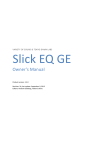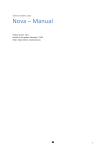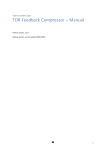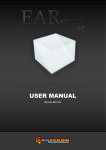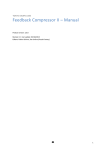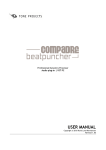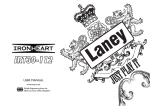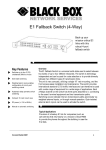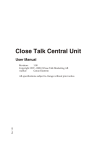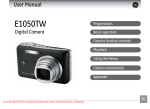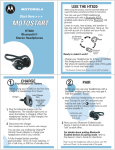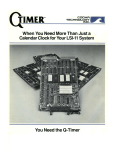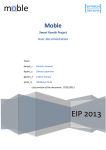Download TDR VOS SlickEQ - Manual
Transcript
VARIETY OF SOUND & TOKYO DAWN LABS Slick EQ Product version: 1.2.0 Revision: 150, last update: September 9, 2015 Editors: Herbert Goldberg, Fabien Schivre – Owner’s Manual The Concept ............................................................................................................................................................ 4 Main Controls .......................................................................................................................................................... 5 EQ Model............................................................................................................................................................. 5 Model: American ................................................................................................................................................. 5 Model: British ...................................................................................................................................................... 6 Model: German ................................................................................................................................................... 7 Model: Soviet ...................................................................................................................................................... 8 EQ Saturation ...................................................................................................................................................... 8 High Pass Filter .................................................................................................................................................... 9 Low Frequency Band ........................................................................................................................................... 9 Mid Frequency Band ........................................................................................................................................... 9 High Frequency Band .......................................................................................................................................... 9 Output Stage ..................................................................................................................................................... 10 Output Gain And Auto Gain .............................................................................................................................. 10 Bypass ............................................................................................................................................................... 11 Quality ............................................................................................................................................................... 11 Process-Target................................................................................................................................................... 11 Secondary Controls / Toolbar ............................................................................................................................... 12 Undo/Redo ........................................................................................................................................................ 12 Preset Management .......................................................................................................................................... 12 A/B Control........................................................................................................................................................ 13 Help Mode......................................................................................................................................................... 13 Settings .............................................................................................................................................................. 13 Info/About Page ................................................................................................................................................ 13 Context Menu ................................................................................................................................................... 13 Installation ............................................................................................................................................................ 14 Get in touch! ......................................................................................................................................................... 14 Technical specifications......................................................................................................................................... 14 Credits ................................................................................................................................................................... 14 Disclaimer and License .......................................................................................................................................... 16 2 Thank you for choosing a Tokyo Dawn Labs product! 3 THE CONCEPT TDR VOS SlickEQ is a mixing/mastering equalizer designed for ease of use, musical flexibility and impeccable sound. Three (and a half) filter-bands arranged in a classic LOW/MID/HIGH semi parametric layout offer fast and intuitive access to four distinct EQ modes, each representing a set of pre-defined EQ curves and behaviors. In order to “warm up” the material with additional harmonic content, SlickEQ offers a switchable EQ nonlinearity and an output stage with various saturation models. These options are meant to offer subtle and interesting textures, rather than obvious distortion. The effect is made to add the typical “mojo” often associated with high quality analogue audio gear. An elaborate auto gain option automatically compensates for changes of perceived-loudness during EQ (within reasonable limits) and a gain-trim feature helps controlling peak overloads with ease. The 64bit multi-rate processing scheme (a.k.a. “oversampling”) practically eliminates typical problems of digital EQ implementations such as frequency-warping, quantization distortion and aliasing. Beside the primary controls, the plug-in comes with an array of additional helpers: Advanced preset management, undo/redo, quick A/B comparison, copy & paste, an online help, editable labels, mouse-wheel support and much more. Finally, SlickEQ allows to exclusively process the stereo sum or stereo difference without additional sum/difference encoding (see “M/S” microphony). SlickEQ is a collaborative project by “Variety of Sound” (Herbert Goldberg) and “Tokyo Dawn Labs” (Vladislav Goncharov and Fabien Schivre). 4 MAIN CONTROLS EQ MODEL One of four different EQ models (curves and behaviors) can be selected via the central drop down menu or cycled through with the help of prev/next buttons. The interface’s background color changes depending on the selected model. The models represent a specific set of curves and EQ behaviors each providing their own musical “feel”. The different names and colors have no deeper meaning, they are meant to help with memorization and identification of the different models. MODEL: AMERICAN Classy and gentle slopes, American style. Proportional Q design. American model: Bell filter cut/boost range American model: Shelving filter(s) cut/boost range 5 MODEL: BRITISH Slightly steeper curves with more “grab” and a subtle shelving “dip”. A proportional Q design with distinct differences between boost and cut operations. British model: Bell filter cut/boost range British model: Shelving filter(s) cut/boost range 6 MODEL: GERMAN Special “tilt” shelving filters with large linear transitions (at low amounts of boost/cut). Well suited for corrective duties or mastering tasks. German model: Bell filter cut/boost range German model: Shelving filter(s) cut/boost range 7 MODEL: SOVIET Unique inverse proportional curves with increasingly smooth curves as the gain is increased. Soviet model: Bell filter cut/boost range Soviet model: Shelving filter(s) cut/boost range EQ SATURATION The EQ SAT button activates a smooth non-linearity inside the filter network. This generates “musical” amounts of harmonic distortion, which purely affect EQ boosts. In other words, no EQ boost = no saturation. 8 HIGH PASS FILTER High-pass filter frequency controls an 18db/Octave Butterworth filter. To disable the filter, turn the knob fully counter-clockwise. The control will grey out to indicate its disabled state. LOW FREQUENCY BAND The low-band section features low-shelving and bell shaped control over the low frequency region. Use the buttons at the bottom of the section to select an appropriate shape. Frequency controls the center frequency of the selected filter-shape. Gain controls the amount of boost or reduction applied to the selected frequency region. Note: The exact shape of the curve depends on the selected EQ Model, as well as on the selected corner frequency and gain. MID FREQUENCY BAND The mid frequency band consists of a bell shaped filter. Frequency controls the center frequency of the bell. Gain controls the amount of boost or reduction. Note: The exact shape of the curve depends on the selected EQ Model, as well as on the selected corner frequency and gain. HIGH FREQUENCY BAND The high-band section features high-shelving and bell shaped control over the high frequency region. Use the buttons at the bottom of the section to select an appropriate shape. Frequency controls the center frequency of the selected filter-shape. Note that SlickEQ offers a wide range up to 40 kHz. Gain controls the amount of boost or reduction applied to the selected frequency region. Note: The exact shape of the curve depends on the selected EQ Model, as well as on the selected corner frequency and gain. 9 OUTPUT STAGE The output stage section offers access to five different models: Linear: As clean as it gets, absolutely linear. Silky: Dynamic saturation with an “open” character. Generates low order, even and odd harmonics (average case). Mellow: Subtle warming. Generates a very low level odd order harmonics series with a dominant 3rd partial (average case). Deep: Dynamic odd order distortion with a distinct frequency dependent touch for increased depth and dimension. Funky: Input transformer behavior including magnetic hysteresis. Calibrate allows to adjust the output stage model “drive” in decibel. It gives control over the amount of generated harmonic content without the need to use clumsy input/output drive techniques. OUTPUT GAIN AND AUTO GAIN Output gain adjusts the output gain in decibel. A red overload-hold LED activates whenever the output signal exceeds 0dBfs, and remains active until re-set. The max-peak history is automatically reset as soon an as audio parameter changes. A left-click on the LED forces a re-set manually. Holding the mouse-cursor over the overload LED enables a secondary output gain trim mode which shows the difference between 0dBfs and the current max peak history value. A left click on the trim display sets the output gain as indicated (which practically “normalizes” the plug-in’s output gain). Any click outside the region disables the trim mode again. The AUTO button activates the auto-gain mode. This mode tries to preserve the subjective loudness during EQ while operating the EQ. This mode gives a much better idea of what the EQ is really doing to the material, because it strongly reduces perception issues related to gain differences. In other words, boosts don’t automically give the impression to sound better and cuts tend to sound far less “boring” than they seem without auto-gain (or careful manual loudness matching). A blue LED indicates auto-gain activity. 10 BYPASS Bypasses the whole processor. Processor latency is accurately compensated and the actual processing is never interrupted (gap-less) to enable better comparisons. QUALITY SlickEQ supports two quality modes: Full SlickEQ’s high quality processing mode. Eco Economic and low latency mode. Note that “Eco” disables all nonlinearities such as EQ Sat and OutStage. Note that any change of quality mode also affects plugin latency. It is probable that the plugin-host playback requires to be reset (stop>play) in order to refresh latency compensation. PROCESS-TARGET The plugin can be processed in Stereo, Mono, Left, Right, Sum and Diff mode. Sum and Diff represents Mid/Side processing. 11 SECONDARY CONTROLS / TOOLBAR UNDO/REDO The undo/redo buttons allow to navigate previous control states. The exact event is shown in a tool-tip. Note that certain controls are not tracked by this function (e.g. "Bypass"). PRESET MANAGEMENT The preset drop-down list gives quick access to factory and user presets. Alternatively, up/down buttons allow to cycles through them. The context menu (right-click) to offers several preset related options: Reset to Original state re-sets the preset to its original state. Save As New Global User-Preset opens a dialog used to create User Presets. These presets persist across sessions and DAWs (presets are saved on your machine). See section “Context Menu” below for details about the Copy/Paste/Share State options. 12 A/B CONTROL A/B allows to quickly compare two alternative control settings. A>B or B<A copies one state to the other. HELP MODE The online help mode offers detailed information about the different elements of the user-interface. Click the "?" button to activate the online help move and move the mouse-cursor above the control of interest. A mouse-click closes the help-mode again. SETTINGS The settings button opens a dialog which gives control over additional user interface settings and latency information. INFO/ABOUT PAGE Opens a dialog with detailed information about the plug-in version, authors and contributors, as well as external links. CONTEXT MENU Open the general context-menu to access copy and paste functions which allow copying control states (i.e. “presets”) across plugin instances and plug-in hosts. Additionally, “share state” opens a dialog with additional preset sharing options via e-mail or internet forums. 13 INSTALLATION Windows: 1. Run the provided installer and follow the instructions Mac OS: 1. Open the dmg-archive (double-click). 2. Double-click pkg-file to install VST and AU plugins. 3. Follow given instructions. GET IN TOUCH! We want to hear your opinion! Reach us via one of the websites below: Check out the Tokyo Dawn Labs website for feedback, news, updates and downloads: http://www.tokyodawn.net/tokyo-dawn-labs/ You can also directly head to the TDR VOS SlickEQ page: http://www.tokyodawn.net/tdr-slickeq/ TECHNICAL SPECIFICATIONS Available binaries: Input / Output resolution: Internal resolution: Latency (44.1 – 48 kHz): Latency (88.2 – 96 kHz): Latency (176.4 – 192 kHz): Supported sample-rates: Supported channel configuration: VST and AU, both in 32bit and 64bit 32bit floating point 64bit floating point 183 samples / 16 samples (eco mode) 171 samples / 16 samples (eco mode) no latency From 44.1 kHz to 192 kHz Mono and Stereo CREDITS Original idea by Vladislav Goncharov and Herbert Goldberg. DSP code by Vladislav Goncharov, Herbert Goldberg and Fabien Schivre. GUI design and implementation by Fabien Schivre. Evaluation and quality assurance by: Dax Liniere (Puzzle Factory), Dean “necromachine”, Gregg Janman (Hermetech Mastering), Ilpo Karkainen (Resoundsound), Ilya Orlov, Jeff Rippe "Nonlinear", Jonas Ekström (Mastertone), Laurent Sevestre (Maximalsound), Mario "EvilDragon", Mario "susiwong", Miguel Marques (Bender Mastering Studio), Murray Campbell "Beatworld", Niklas Silen "bmanic", Roland Löhlbach “Compyfox”, Shane Johnson and Vitaly Zolotarev. VoS logo designed by Patrick Barca. Frequency magnitude plots made with VSTAnalyser. 14 Copyright © Tokyo Dawn Records. All rights reserved. 15 DISCLAIMER AND LICENSE The contained software is given to use under a freeware license. This software is provided free of charge but the authors retain copyright. You are not allowed to distribute this software including but not limited to making the software available for download or making this software part of a software CD/DVD/Blue-ray compilation. You are not allowed to sell or to rent this software. You are not allowed to reverse engineer this software. You are allowed to use this software for any artistic application including commercial music production. This software is provided 'as-is', without any express or implied warranty. In no event will the author be held liable for any damages arising from the use of this software. “VST” is a Technology and Trademark by Steinberg. All other mentioned trademarks and brands belong to their respective owners. 16
















